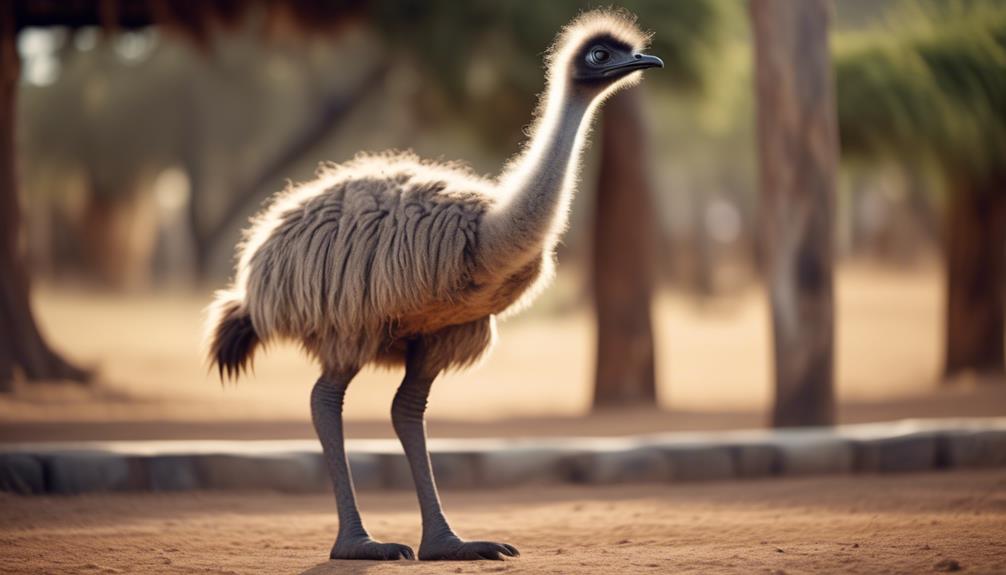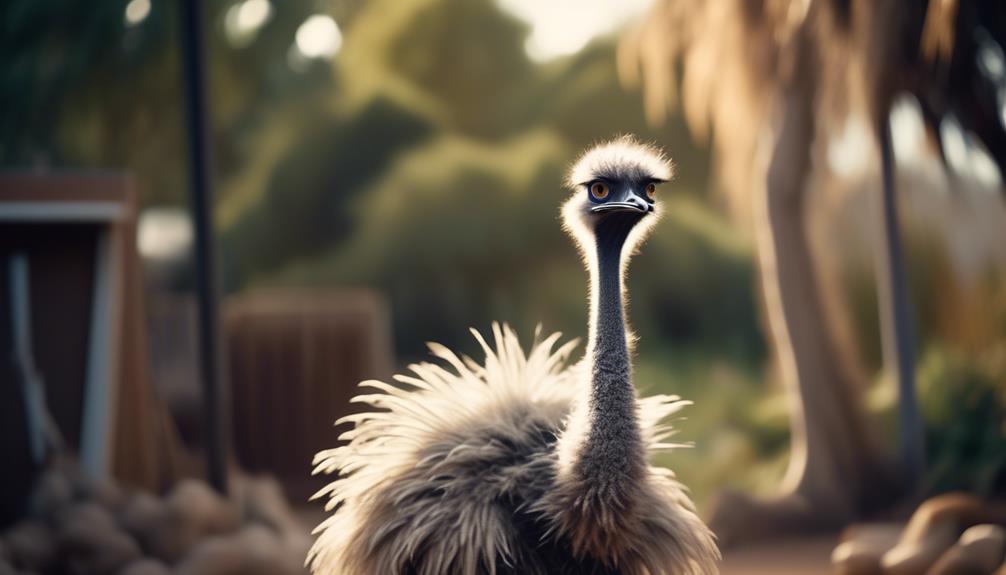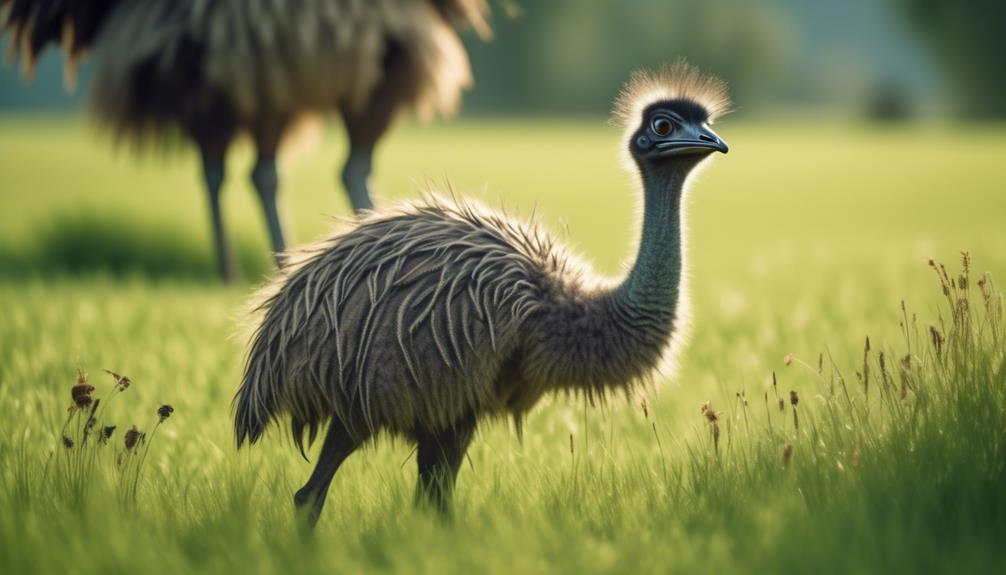As you observe the majestic emu stepping out of its shell, you are immediately struck by the wonder of its growth and development. From the moment it enters the world, this fascinating creature embarks on a journey of milestones and transformations that shape its life.
From the early stages of hatching to the complexities of adult behavior, documenting the growth of an emu offers a captivating glimpse into a world of constant change and fascinating adaptations.
But how exactly does an emu progress from a vulnerable hatchling to a powerful, fully-grown bird? Let's explore the milestones and development of these incredible creatures together.
Key Takeaways
- Emus go through various developmental stages, including feather development, leg strength development, plumage development, and adolescent growth and maturation.
- Emu chicks have down feathers at hatching, which are gradually replaced by structured feathers.
- Leg muscle development is crucial for emus to walk and run, and playful activities contribute to leg strength development.
- Emus undergo hormonal changes during adolescence, which affect their growth, behavior, and reproductive capabilities.
The Hatching Stage
During the hatching stage, emus undergo a remarkable transformation as they emerge from their eggs, demonstrating a rapid development that sets the foundation for their growth and survival. The incubation period for emu eggs lasts approximately 50 to 55 days. Throughout this period, the male emu takes charge of egg care, diligently turning and rotating the eggs to ensure uniform heat distribution and proper development. This process is crucial as it facilitates the exchange of gases and prevents the embryos from sticking to the inner shell membrane.
As the hatching day approaches, the emu chicks start peeping inside their eggs, signaling their readiness to break free. They use a specialized egg tooth, located on the tip of their beak, to puncture the shell. This tooth is a temporary structure that falls off shortly after hatching. The chicks use their legs to push against the shell, exerting pressure until it cracks open, allowing them to emerge into the world.
Once hatched, the emu chicks are covered in soft, downy feathers, which provide insulation and protection. They're precocial, meaning they're capable of moving and feeding themselves shortly after hatching. Their rapid development during this stage ensures they're equipped to face the challenges of their environment, such as predators and limited food resources.
Early Growth and Feathers
As the emu chicks break free from their shells, they begin their early growth phase, which is characterized by the development of their feathers. Feather development in emus is a fascinating process that undergoes several stages. Shortly after hatching, the chicks have a sparse covering of down feathers, which provide insulation and protection. These down feathers are soft and fluffy, providing warmth to the growing chicks.
Over the next few weeks, the emu chicks undergo rapid feather growth. The down feathers are gradually replaced by contour feathers, which are stiffer and more structured. These contour feathers play a crucial role in flight and thermoregulation as the chicks continue to grow. As the chicks mature, their feathers become stronger and more durable.
Feather molting is a natural process where old or damaged feathers are shed and replaced with new ones. Emus typically molt their feathers once a year, usually during the warmer months. During the molting process, the emus may appear scruffy and disheveled as they shed their old feathers. However, this is a necessary part of their growth and ensures that they have healthy and functional plumage.
Development of Leg Strength

Emu chicks undergo a gradual process of developing leg strength, which is essential for their locomotion and overall physical development. Leg muscle development plays a crucial role in enabling emus to walk, run, and engage in various activities necessary for survival. As the chicks grow, their leg muscles gradually strengthen, allowing them to support their body weight and navigate their environment with ease.
Exercise for leg strength is a natural part of an emu chick's daily routine. From an early age, these curious creatures actively explore their surroundings, which requires them to move around and engage their leg muscles. They take small, wobbly steps, gradually increasing the duration and intensity of their movements. This gradual progression helps in the development of their leg muscles, making them stronger and more capable.
Additionally, emu chicks engage in playful activities that further contribute to their leg muscle development. They engage in short bursts of running, hopping, and jumping, which not only strengthens their leg muscles but also improves their agility and coordination. These activities help them build the necessary strength and endurance to navigate their environment and ultimately survive in the wild.
Formation of Juvenile Plumage
The formation of juvenile plumage in emu chicks is a gradual and intricate process, marked by distinct changes in their feather structure and coloration. As emu chicks grow, their feathers undergo a series of developmental stages, transitioning from downy feathers to fully formed adult plumage.
Feather development in emu chicks begins shortly after hatching. At this stage, the chicks are covered in soft and fluffy down feathers that provide insulation and protection. Over time, these down feathers are gradually replaced by more structured feathers, starting with the wing feathers and progressing to the body feathers.
A key milestone in the formation of juvenile plumage is the molting process, which occurs when the chicks are around 6 to 8 months old. During this time, the chicks shed their old feathers and replace them with new ones. This molt allows the emu chicks to acquire their characteristic adult plumage, which is typically dark brown in color.
To better understand the changes in feather development during the formation of juvenile plumage, the following table provides a summary of the stages and corresponding feather characteristics:
| Stage | Feather Characteristics |
|---|---|
| Down feathers | Soft, fluffy, and provide insulation |
| Wing feathers | Begin to develop structure and shape |
| Body feathers | Replace down feathers, more structured |
| Molting process | Shedding of old feathers, growth of new ones |
| Adult plumage | Dark brown color, fully formed feathers |
Through the intricate process of feather development and molting patterns, emu chicks gradually transform into adults with their characteristic plumage. Understanding these milestones in emu growth provides valuable insights into their development and contributes to our knowledge of these fascinating birds.
Adolescence and Rapid Growth

During the period of adolescence, emus experience a significant growth spurt as their bodies rapidly develop towards adulthood. This phase is marked by intense physical changes as well as hormonal fluctuations that play a crucial role in their overall development.
Emus undergo dramatic growth spurts during adolescence, and their bodies undergo rapid changes to accommodate their increasing size and strength. This growth spurt is fueled by the surge of hormones that occur during this stage of development. The production of growth hormones, such as testosterone and estrogen, is responsible for the accelerated growth and maturation of various body parts, including bones, muscles, and feathers.
As emus enter adolescence, their bone structure undergoes significant transformation. The long bones lengthen and thicken, allowing the emus to reach their full adult height. This growth spurt is also accompanied by an increase in muscle mass, contributing to their overall physical strength and agility.
In addition to the physical changes, hormonal changes during adolescence also affect the emus' behavior and reproductive capabilities. The surge in testosterone levels in males can lead to increased aggression and territorial behavior, while females experience changes in their reproductive organs in preparation for future breeding.
Maturation of Sexual Characteristics
While undergoing maturation, emus develop distinctive sexual characteristics that differentiate between males and females. Hormonal changes play a significant role in the development of these characteristics.
In males, the increase in testosterone levels during maturation leads to the growth of primary sexual characteristics such as the enlargement of the testes and the development of the phallus. Additionally, secondary sexual characteristics such as the growth of bright blue skin around the eyes and neck, as well as the emergence of a deep, resonant drumming sound, become more prominent. These changes are essential for attracting mates and establishing dominance within a social group.
In females, maturation is marked by the development of primary sexual characteristics such as the growth of ovaries and the formation of a reproductive tract. Additionally, secondary sexual characteristics become more apparent, including the development of a lighter shade of blue skin around the eyes and neck, as well as the ability to respond to male courtship displays.
Reproductive behavior also undergoes significant changes during maturation. Males engage in elaborate courtship displays, such as puffing up their feathers and performing a rhythmic dance, to attract females. Females, on the other hand, become more receptive to mating, displaying behaviors like crouching and vocalizing to signal their readiness.
Establishment of Social Hierarchy

Emus establish a social hierarchy through a complex system of dominance and submission behaviors. Dominance behavior in emus involves displays of aggression, such as puffing up their feathers, flapping their wings, and emitting low-frequency vocalizations. The dominant emu asserts its authority by pecking and chasing subordinate individuals. This hierarchical structure allows emus to establish order and reduce conflicts within their groups.
Social interactions among emus are essential for the establishment and maintenance of the social hierarchy. Emus engage in various behaviors to communicate dominance or submission. For instance, individuals lower their heads and necks as a sign of submission, while dominant emus hold their heads high and maintain a confident posture. These interactions help emus understand their place within the group and avoid unnecessary confrontations.
The dominance hierarchy in emus is dynamic and can change over time. Emus may engage in aggressive encounters to challenge the existing hierarchy. These confrontations involve physical contests, such as pushing and shoving, and vocal displays. The outcome of these interactions determines the reshuffling of positions within the hierarchy.
Understanding the establishment of the social hierarchy in emus provides insights into their behavior and social dynamics. Emus rely on dominance and submission behaviors to maintain order and cooperation within their groups. By studying these interactions, researchers can gain a better understanding of the complex social structure of emus and how it influences their overall development.
Nesting and Reproduction
The nesting and reproduction process in emus involves a series of distinct stages and behaviors. Understanding these processes is crucial for gaining insights into their reproductive biology.
Here are the main aspects of emu nesting and reproduction:
- Emu Mating Rituals: Emus are monogamous birds, meaning they form long-term pair bonds. During the breeding season, which typically occurs between April and June, male emus engage in elaborate courtship displays to attract females. These displays involve puffing up their feathers, emitting low booming calls, and performing a unique dance by extending their neck and tail feathers.
- Egg Laying: After mating, female emus lay their eggs. They create a shallow nest on the ground, usually in a hidden location like dense shrubs or tall grass. Each female lays a clutch of large, dark green eggs, typically numbering between 5 and 15.
- Incubation Process: Once the eggs are laid, it's the male emu's responsibility to incubate them. He diligently guards the eggs and sits on them for about 8 weeks, rarely leaving the nest. This behavior is unique among birds, as most species have the female incubating the eggs. The male emu turns the eggs periodically to ensure even heat distribution, using the brood patch on his belly.
- Hatching and Rearing: After the incubation period, the eggs hatch, and the male emu cares for the newly hatched chicks, known as 'stripeys'. He protects and nurtures them until they're independent enough to venture out on their own, usually after several months.
Understanding the nesting and reproduction process in emus provides valuable information about their reproductive strategies and the behaviors necessary for the survival of their offspring.
Adult Emu Feeding Habits

During the nesting and reproduction process, understanding the feeding habits of adult emus is essential for comprehending their overall survival strategies and reproductive success. Adult emus have specific dietary preferences and exhibit unique foraging behavior. These habits play a crucial role in their ability to obtain sufficient nutrients and energy for their daily activities.
Emus are omnivorous, meaning they consume both plant and animal matter. However, their diet primarily consists of plant materials such as fruits, seeds, leaves, and flowers. They also consume insects, small vertebrates, and even carrion when available. This varied diet allows emus to adapt to different environments and seasons.
Emus employ a foraging behavior known as pecking, where they use their sharp beaks to pick up food from the ground. They're opportunistic feeders, constantly scanning their surroundings for potential food sources. Their long legs and necks enable them to efficiently reach foliage at different heights. Additionally, emus have a crop, a specialized pouch in their esophagus, which allows them to store and partially digest food.
When it comes to feeding, adult emus prioritize their own nutrient needs over those of their offspring. This strategy ensures that they maintain optimal health and condition, which in turn contributes to successful reproduction and survival.
Emu Life Span and Aging Process
As emus age, their life span and aging process undergo significant changes that can impact their overall health and vitality. Understanding the longevity of emus and the signs of aging is crucial for their proper care and management.
Here are some key points to consider:
- Emu longevity: On average, emus can live up to 20 years in the wild, but in captivity, they've been known to live even longer, reaching up to 30 years. Factors such as genetics, diet, and environmental conditions can influence their lifespan.
- Physical changes: As emus age, they may experience a decline in their physical abilities. Their feathers may become dull and lose their vibrant colors. They may also develop joint problems, leading to difficulties in movement.
- Behavioral changes: Older emus may exhibit changes in their behavior. They may become less active and spend more time resting. Their mating behaviors may also decrease, and they may become more solitary.
- Health issues: Aging emus may be more prone to certain health issues such as arthritis and obesity. Regular veterinary check-ups and a balanced diet can help manage these conditions and ensure their overall well-being.
Frequently Asked Questions
What Are the Different Stages of Emu Growth and Development?
During emu growth and development, there are various stages to consider. Understanding the impact of their diet on growth and reproduction is crucial. Learning about their breeding behavior and reproductive cycle helps document their milestones.
How Long Does It Take for an Emu to Hatch From Its Egg?
An emu typically takes around 50 to 55 days to hatch from its egg. The emu incubation period can vary slightly depending on environmental factors, such as temperature and humidity levels.
What Are the Factors That Contribute to the Formation of Juvenile Plumage in Emus?
Factors affecting the formation of juvenile plumage in emus include genetics, environmental conditions, and diet. Research shows that the emu's feather development is influenced by their diet, with certain nutrients playing a crucial role in coloration.
Do Emus Go Through Any Significant Growth Spurts During Adolescence?
During adolescence, emus experience significant growth spurts which can impact their social dynamics. These growth spurts result in changes in size and strength, influencing how they interact with other emus and establish their place in the hierarchy.
How Do Emus Establish Their Social Hierarchy Within a Group?
Emus establish their social hierarchy through a complex dance of dominance and submission. It's like a choreographed ballet, with individuals jostling for position and asserting their authority. Understanding emu social dynamics is key to comprehending hierarchy formation within their groups.
Conclusion
In conclusion, the growth and development of emus is a remarkable journey filled with impressive milestones.
From the hatching stage to the establishment of social hierarchy, these birds undergo significant transformations.
Their leg strength, feathers, and plumage all play vital roles in their survival and adaptation.
The emu's adolescence and rapid growth are truly awe-inspiring, while their nesting and reproductive behaviors highlight their commitment to future generations.
With their unique feeding habits and impressive life span, emus continue to fascinate scientists and enthusiasts alike.




